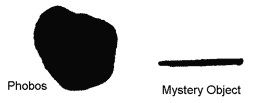 |
Science Frontiers ONLINE No. 82: Jul-Aug 1992 |
|
|
The Phobos Mystery Object
On March 28, 1989, Russian ground controllers suddenly and unexpectedly lost contact with their spacecraft that was shadowing the Martian moon Phobos. The last close-up photo of Phobos snapped by the spacecraft contained "an object which shouldn't have been there."
Naturally, this Phobos Mystery Object (PMO) was quickly dubbed a UFO by some. It was even speculated that the Russian mission had been deliberately terminated by aliens! Such a scenario dovetailed neatly with the old speculations that Phobos is actually an artificial satellite of Mars, which is being used as a base of operations by someone or something.
 |
The final photo of Phobos, taken in infrared light just three days before the communication failure, reveals the outlines of both Phobos and the PMO. All surface detail is washed out, as is common in infrared photographs. If the PMO was at the same distance as Phobos itself, it would be about 2 kilometers wide and 20 long. Its surface brightness is the same as that of Phobos. The sides of the PMO are perfectly parallel; it is rounded at both ends; the end towards Phobos narrows slightly; the other end seems to have a slight protrusion.
Since the PMO does not appear to have a metallic surface and displays no antennas or other indicators of artificiality, it is reasonable to ask whether it might be some natural phenomenon. One possibility is that the PMO image is only a "trailed moonlet;" that is, the smeared image of a small piece of debris also in orbit about Mars but moving at a slightly different velocity from that of the spacecraft and Phobos. Since the exposure time of the last photo was 8 seconds, a smeared image due to the PMO's relative motion is reasonable.
(Anonymous; "Mystery Object Encountered by Russian Phobos Spacecraft," Meta Research Bulletin, 1:1, March 15, 1992. This new newsletter, edited by astronomer T. Van Flandern, focusses on astronomical anomalies. Address: P.O. Box 15186, Chevy Chase, MD 20815.)